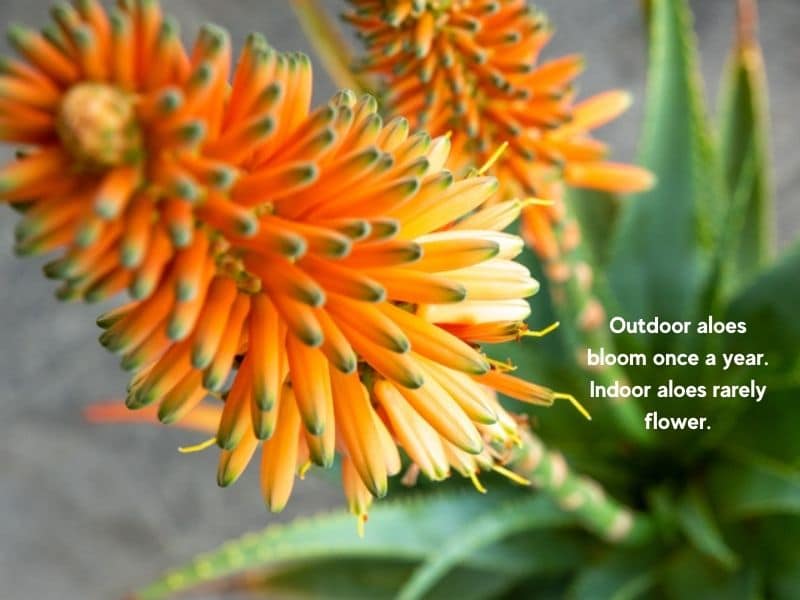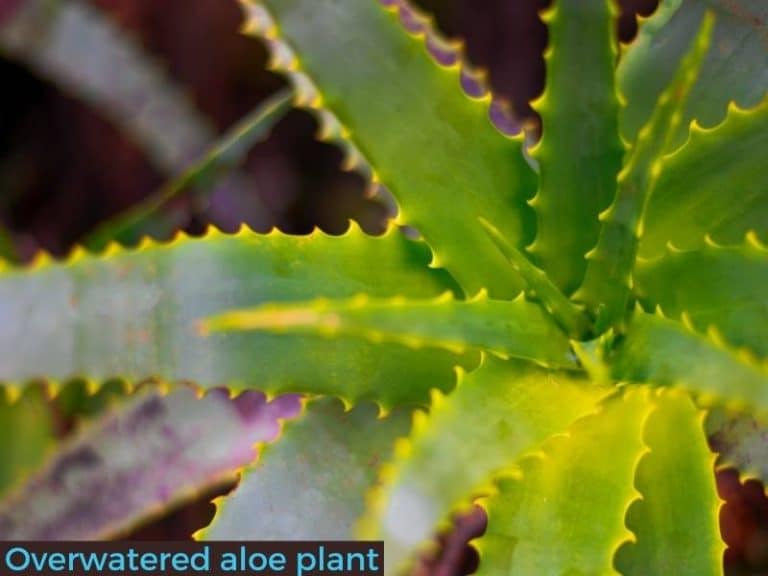Do Aloe Vera Plants Bloom? How Often, Care + Flower Colors
Aloe vera blooms add lots of visual intrigue to landscapes but are not always guaranteed to appear. In fact, not all aloe vera plants produce blooms, and those that do only flower once per year.
Indoor aloe vera plants rarely bloom but those grown outdoors can produce flowers if provided with sufficient water, sunlight, and fertilizer. In tropical climates and USDA hardiness zones 9-11, aloe plants produce flowers any time between spring and summer.
There are multiple ways you can get your aloe vera plant to bloom. These include providing the appropriate light and temperature conditions, sticking to the proper fertilization and watering schedule, and transplanting the aloe vera pups.
Do all aloe vera plants bloom?

Not all aloe vera plants bloom and those that are grown indoors barely ever produce flowers. However, mature aloe vera grown in outdoor gardens will readily bloom.
Young aloe vera plants (less than four years old) will also not produce any blossoms, even in outdoor settings. For this species of succulent, blooming only begins once the rosette branches out into thick stems.
Aloe vera plants are more likely to produce flowers if grown in USDA hardiness zones 9-11. These regions have the most favorable temperature conditions for this plant species to thrive and blossom.
How often do aloe plants bloom?
Aloe vera blossoms once annually usually from early spring-summer, which is its peak growth season. However, depending on where you live, you may notice sporadic blooming during any of the other seasons.
Take note though, that in the Northern hemisphere, aloe vera bud development starts in winter when temperatures are lowest and days are shorter (meaning fewer hours of sunlight). However, the flower buds develop at a slow rate and by the time they turn into visible flowers, it’s usually early spring.
If you’re growing your aloe vera indoors, the plant can live through all four seasons without producing any flower stalks. That’s because for aloe vera to blossom, there has to be adequate sunlight and exposure to pollination agents (wind and bees), which isn’t the case in indoor spaces.
How to Care for a Blooming Aloe Plant
If you have a flowering aloe plant such as aloe vera, you can enhance its chances of producing beautiful blossoms by sticking to the proper care and maintenance routine. This includes providing the appropriate temperature conditions, fertilizing the aloe vera, and watering it when it needs water.
1. Maintain temperature at 70-110°F
Aloe vera plants prefer daytime temperatures of 70-85 degrees Fahrenheit. However, if temperatures exceed 110-degrees Fahrenheit, the plant is likely to suffer leaf burn. Therefore, during warm spring-summer weather, we recommend moving your potted, mature aloe vera outdoors during the day.
This desert succulent will also thrive if nighttime temperatures don’t drop any lower than 60 degrees Fahrenheit. It’s, therefore, advisable to move your aloe vera indoors during the cooler seasons. By sticking to the plant’s preferred temperature conditions, you’ll be boosting its chances of blossoming.
Pro tip: When moving your indoor aloe vera plant to your outdoor garden during summer, don’t directly place it in a spot where it’s directly exposed to full sunlight. This may cause scorched or sunburnt aloe vera leaves and stems, as it needs time to adjust to the increased light conditions. Instead, place your aloe vera in partial shade for about seven days before moving it to a brighter spot.
2. Provide six hours of sunlight per day
Aloe vera thrives in well-lit conditions. The succulent won’t flower if you keep your plant in a dark indoor spot or an outdoor garden that’s heavily shaded from sunlight exposure.
Place an indoor aloe vera plant on a brightly lit window sill such as an east-facing window and ensure it gets a minimum of 6 hours of sunlight per day to encourage it to bloom.
Take note though, that excessive sunlight exposure will scorch the stems of your aloe vera.
3. Use small terracotta pots with drainage holes
Avoid planting your aloe vera in a black-colored pot. That’s because black readily absorbs heat and your aloe plant will suffer sunburn. Even worse, placing the black pot outdoors during summer days will likely exacerbate the problem.
The best pot for aloe vera is a ceramic or a terracotta pot that’s at least 2 inches wider than the width of your aloe plant. Ensure there are drainage holes at the bottom of the pot to prevent waterlogging in the pot that can cause black spots on the aloe plant’s leaves.
Also, aloe vera will more readily bloom in small pots, as the resulting, dense/tightly packed root system encourages flowering. As such, it’s advisable to use small-sized growing containers.
4. Fertilize the aloe vera plant every month
Another effective way to encourage flowering in your indoor aloe vera plant is to fertilize it with a liquid fertilizer at least once every month. Go with a liquid fertilizer mix that’s specially formulated for succulents such as Miracle-Gro Succulent Plant Food.
Meanwhile, for aloe vera growing in outdoor gardens, fertilizing it at least once from late winter-early spring will make the succulent produce flowers. Being a desert plant, aloe vera doesn’t require too much fertilizer to thrive.
Finally, avoid feeding your aloe vera with granular fertilizer that’s high in phosphorus content. Highly-concentrated phosphate formulas may damage the plant’s roots and affect its flowering habits.
5. Water the plant when the soil dries out
For most succulents, fertilization and watering go hand in hand, and aloe vera is no different. By watering your aloe vera at the appropriate times, you’ll be enhancing the succulent’s chances of developing flowers.
Take note too, that aloe vera only needs enough water to prevent it from drying out, and too much water will drown the plant. Always let the top two inches of the soil completely dry out between successive watering sessions. You can always test this out by inserting a finger into the soil mix and feeling for wetness.
I recommend watering aloe vera post-fertilization to drain out any excess salts that may cause fertilizer burn to the roots and prevent them from drawing in nutrients.
Meanwhile, for potted aloes, you should also water the plants at least 24 hours before fertilization to drain out any extra salts left behind from the last time your fertilized the plant.
6. Feed the soil with aloe vera gel
Aloe vera gel can also be used as a sort of natural fertilizer to stimulate flowering in aloe vera plants.
Collect the gel from the leaves of other mature aloe vera plants and mix it with seaweed in a 4:1 ratio before adding a few drops of water. Let the mixture sit in a sealed container for about a week then stir it once every two days for one more week. Apply it to the soil mix of the aloe plant.
7. Repot or transplant your aloe vera biannually
Transplanting potted aloe vera plants boosts the plant’s chances of blooming in two ways. First, if the old soil mix was too compact, the fresh soil mix allows for the roots of the aloe to properly aerate.
Second, the existing soil mix may be laden with excess salts; thus transplanting the plant in fresh soil will prevent root burn and the associated plant stress. You should repot your aloe vera at least once every two years.
8. Propagate the aloe vera offshoots
Aloe vera spends significant amounts of energy to grow offshoots and pups. However, by removing and transplanting the pups, the mother plant redirects this energy towards developing blooms. When transplanting aloe vera offsets, give them about a week to form calluses on the cut-out ends before potting them.
Aloe vera flower colors
Aloe vera blooms typically vary in shades ranging from red, orange, yellow, and white. The vibrant-colored, tall flower spike of aloe vera is commonly referred to as an inflorescence. Aloe vera blooms add a nice ornamental element to both indoor and outdoor settings.
How long does an aloe vera flower last?
Aloe vera plants start budding in late winter, with the vibrant-colored flowers appearing in early spring and lasting up to late summer. As such, you should expect to see beautiful aloe vera flowers for about 2-3 months before they die out.
Pro tip: Contrary to common belief, aloe vera plants don’t die out after the blooms disappear. Your aloe vera plant will still thrive even after the flowers disappear. Pruning helps with plant health post-blooming.
References
- Emma Erler, Landscape and Greenhouse Field Specialist, Instructor Field Specialist, University Of New Hampshire: What Should I Know About Growing Aloe at Home?
- NC State University Cooperative Extension: Aloe Vera Plant Care and Guidelines




I live in Ontario , Canada.winter temperature can drop to -34 c. Summer temp can rise to 28c. I have an indoor aloe Vera plant about 10 years old and its forming its first bloom. So exciting. I found your article very interesting and helpful.
I live in North Idaho, I bought a three inch potted Aloe Vera in a grocery store three or four years ago, it has grown to almost 3 foot tall. I keep it in a south facing window, we have very short winter days, and little winter sun. My Aloe is blooming now, I was shocked because we had never seen one bloom. Thank you for the information.
If my aloe needed to be repotted, but is now blooming should I wait until it is finished or repot it now?
It is best to wait.
I live in southern Ontario Canada. Just found a flower stalk on my aloe vera. I did not know they bloomed. I bought it in a supermarket 2 years ago and it was quite small. It gets no special attention but is doing very well.
Thanks for the info.
Our aloe Vera plant is blooming didn’t even know so I search… thanks for info
I am in upstate NY. l separated and repotted my aloe early last summer and now the pot is very crowded it even has a shoot (pup?) Growing from outside of the pot base. And now it has a flower stalk. I am very surprised and can’t wait to see how it turns out